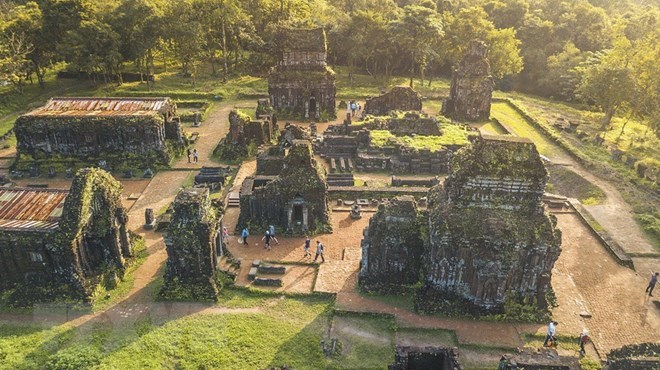
Tower K, a rare building remaining in the complex of temples at My Son Sanctuary in Duy Xuyen district, the central province of Quang Nam, is now ready to welcome visitors after being upgraded with the support of Indian experts.

My Son Sanctuary comprises eight groups of 71 monuments built
throughout the 7th -13th centuries. (Source: VNA)
The upgrading is part of the first phase of a restoration project of the My Son
sanctuary from 2017-2018, under which Indian experts have also helped
consolidate Tower H in the complex.
During the restoration process, Vietnamese and Indian experts discovered walls,
stone lion statutes and objects, which are now preserved
scientifically.
In 2017, the My Son Sanctuary welcomed 290,000 tourists, up more than 10
percent year-on-year, raking in nearly 50 billion VND (2.15 million USD).
Once the religious and political capital of the Champa Kingdom, My Son
Sanctuary is located in a hilly landscape in Duy Phu commune, Duy Xuyen
district, about 70 km southwest of central Da Nang city and 40 km from Hoi An
city.
It comprises eight groups of 71 monuments built throughout the 7th -13th
centuries.
The first construction of My Son dates back to the 4th century under the reign
of Bhadravarman for the worship of God Shiva-Bhadresvara. But later on, the
temple was destroyed.
At the beginning of the 7th century, King Sambhuvarman had it rebuilt and
rebaptised Sambhu-Bhadresvara. Each new monarch came to My Son after his
accession to the throne for the ceremony of purification and to present
offerings and erect new monuments, which explains why My Son is the only place
where Cham art flourished without interruption from the 7th to 13th century.
Source: VNA
The clothing of women reflects the culture of the Muong, Thai, Tay, Dao, and Mong ethnic groups in the northern province of Hoa Binh.
Gongs hold a special place in the cultural and spiritual life of the Muong ethnic people in Hoa Binh province. More than musical instruments, they are an indispensable part of community rituals and collective memory, echoing through generations as a spiritual thread linking the past, present, and future.
Preserving and promoting the cultural values of the Muong ethnic group has become an urgent task in the current context, as many traditional values face the risk of fading away. This effort requires not only protecting the cultural identity but also eliminating outdated customs and developing a modern cultural lifestyle, contributing to sustainable values for the Muong community in Hoa Binh province.
The Muong ethnic culture, deeply rooted in Vietnam’s mountainous north, continues to be preserved and revitalised by dedicated individuals and communities determined to safeguard their ancestral identity.
The Muong group is one of the largest ethnic minorities in Vietnam, primarily found in Hoa Binh province. The Muong people in Hoa Binh boast a rich and diverse cultural treasure that reflects the unique identity of this ethnic group. Accounting for over 63% of the province's population, they have created and preserved numerous distinctive cultural values, contributing to their unique identity. Their cultural heritage is an invaluable asset, at the heart of their national identity, and represents a vibrant spiritual life that must be preserved and promoted in today’s modern world.
For generations, the ethnic communities of Hoa Binh province, particularly the Muong people, have preserved vibrant festivals deeply intertwined with the region’s geography, nature, and social traditions. These celebrations enrich Hoa Binh’s spiritual life and cultural identity, reflecting both folk beliefs and the intermingling of ethnic customs. Many of these festivals have endured the test of time, passed down through generations and continuing to thrive today. Among them, the Khai Ha (Going Down to the Field) festival stands out as one of the most significant events of the Muong ethnic group.



